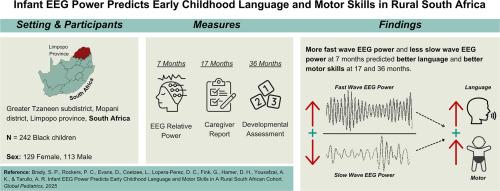Infant EEG power predicts early childhood language and motor skills in a rural South African cohort
引用次数: 0
Abstract
Early neural development underlies fundamental behavioral outcomes. In low- and middle-income countries (LMICs), healthy development is often perturbed by compounded adversities, yet little is known about the neural mechanisms driving these trajectories. The current study explores the relationship between infant EEG power and early childhood developmental outcomes at two timepoints in the Greater Tzaneen subdistrict, Mopani district, Limpopo Province, South Africa. In a sample of 242 children, we assessed how EEG relative power at seven months related to development at 17 and 36 months. Increased left hemisphere theta band activity (4–6 Hz) predicted lower caregiver-reported language and motor skills, and increased left hemisphere beta activity (13–30 Hz) predicted reported motor skills at 17 months. Increased infant gamma power (30–48 Hz) in the left hemisphere was associated with higher observed language and gross motor skills at 36 months. Results suggest that early neural oscillations have small but consistent associations with later language and motor skills in a LMIC context.

在南非农村的一个队列中,婴儿脑电图功率可以预测儿童早期的语言和运动技能
早期神经发育是基本行为结果的基础。在低收入和中等收入国家(LMICs),健康发展往往受到复杂逆境的干扰,但对驱动这些轨迹的神经机制知之甚少。本研究在南非林波波省莫帕尼区Greater Tzaneen街道的两个时间点探讨了婴儿脑电图功率与儿童早期发育结果之间的关系。在242名儿童的样本中,我们评估了7个月时的脑电图相对功率与17和36个月时的发育之间的关系。增加的左半球θ波活动(4-6赫兹)预示着照顾者报告的较低的语言和运动技能,增加的左半球β波活动(13-30赫兹)预示着17个月时照顾者报告的运动技能。在36个月时,婴儿左半球伽马功率(30-48赫兹)的增加与观察到的更高的语言和大运动技能有关。结果表明,早期的神经振荡与LMIC背景下的后期语言和运动技能有很小但一致的联系。
本文章由计算机程序翻译,如有差异,请以英文原文为准。
求助全文
约1分钟内获得全文
求助全文

 求助内容:
求助内容: 应助结果提醒方式:
应助结果提醒方式:


